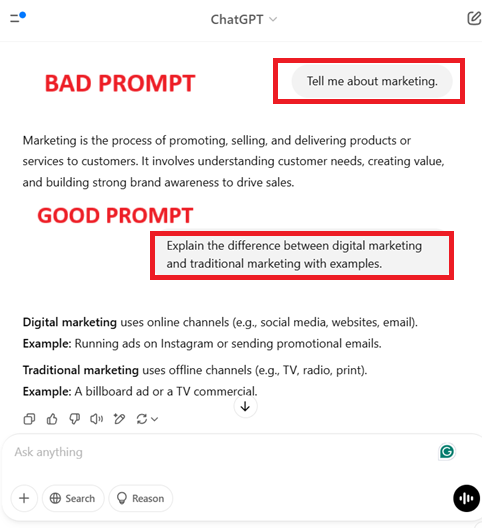Recently, I had a chance to discuss on Prompt Engineering in a 5 days capsule course at Thinkcloudly. And let me tell you—it was a blast. We got into some really interesting conversations around what makes a good prompt, how even tiny tweaks can lead to really different responses, and why prompt engineering is quickly turning into one of the most valuable skills in the world of IT.
I thought it is worth documenting the discussion and learnings in a blog. As it was a 5 day long I am planning to write this blog also in a series this is the first part of the blog. So whether you’re just a beginner into prompt engineering or already playing around with AI techniques, there should be something here for you.
If you’re into AI and love the idea of understanding intelligent models using nothing more than carefully crafted language, you’re in the right place.
AI Is Already All Around Us
Let’s take a step back. Before we get into the Prompt engineering let’s see the bigger picture.
Some of you—especially those in the US, Seattle—might have come across Amazon’s AI-powered stores. Amazon has truly revolutionized the shopping experience with its Amazon Go stores. These are “Just Walk Out” stores where customers can enter by scanning their app, pick up the items they want, and leave without stopping at a checkout counter. No lines. No cashiers. No swiping your credit card.
This store uses advanced AI technologies like computer vision, sensors, and deep learning. Cameras and sensors track which items are picked up from the shelves and automatically charge the customer’s Amazon account when they exit the door.
Cool, right? It knows what item was picked up, how many items are there in your cart, and even if you keep some items back on the shelf, it will update the cart item. This seamless, cashier-less experience is going to change the future, and I feel it is one of the best examples of artificial intelligence use cases in the real world.
Google search, Alexa, Netflix recommendations, Self-driving Tesla cars If we just observe around us, we have been knowingly or unknowingly the users of AI-powered tools for a long time.

What is AI?
So, let’s break the glass. What is AI?
AI stands for artificial intelligence, which actually gives your computer a brain to think, to learn, and to make decisions on its own. Meaning, the computer system is developed in such a way that it will be able to perform those tasks where human intelligence is required.
Like how, Our kids learn from experience. Let’s say you’re teaching a child to recognize different animals. You Show them pictures of a dog, cat, or lion and say, “This is a dog” and “This is a cat.” Over time, The child learns to recognize each animal on their own, even if the picture is a little different. Similarly, machines also learn, and then they not only take instructions and follow them, they also learn from data and experience.
Do you know? The apps like Spotify, Google Ads, YouTube, and Netflix, they observe your (users) behavior and then show you the ads and recommendations from a long time, and this is also nothing but an AI.
Then why did AI become popular now after ChatGPT came? Because ChatGPT is generative AI, whereas the earlier apps are using narrow AI.
Narrow AI (Weak AI)
Narrow AI is designed to do specific tasks and can’t think beyond it’s programming. Like a self driving tesla car which is designed to run on US road it might not function exactly same in other countries as those countries road condition, and rules might differ. It is generally used in industries factories to train the machines to perform a specific task this is the reason it is also considered as weak AI.
Generative AI (Strong AI)
A Generative AI can be multifunctional like humans, where the machine thinks, learns, and reasons like humans. It understands and makes decisions, and it can create new content like text and images. It not only observes and learns from old data,it gives you, unique content like writing a poem, a story, or even crafting a digital marketing ad creative. However, it’s still being improved—researchers are working on it, but it is pretty much powerful.
In a nutshell,AI is a fascinating technology that mimics human thinking and decision-making. It powers many aspects of our lives, from classroom monitoring to everyday tech tools, but it’s not quite as versatile or intelligent as humans.
LLMs: The Brains Behind Generative AI
Large language model is powering the new era of smart AI. A Large Language Model (LLM) is an AI model, like ChatGPT or Google Bard, that is trained to understand and generate human language. It can perform tasks like text summarization, translation, and answering questions.
What is Prompt Engineering?
Now, that we know the LLM models helps us perform tasks like translation, conversation, and creative content generation.
The question is, How to make use of a LLM model to get your things done as per your requirements?
The answer is Prompt – Prompts are nothing but the instructions or the inputs we give to the gen AI LLM tools like chatgpt in order to get the desired outcomes. Think of it as telling the AI what you want — clearly and effectively.
Prompt Engineering is the skill of designing these instructions to get accurate, useful, and creative results from AI models.
Good Prompt vs Bad Prompt: Why Wording Matters
❌ Bad Prompt:
“Tell me about marketing.”
- Too broad and vague
- The AI doesn’t know what aspect of marketing you’re interested in
- The response will likely be generic and not very useful
✅ Good Prompt:
“Explain the difference between digital marketing and traditional marketing with examples.”
- Clear, specific, and targeted
- Guides the AI to give a focused and useful answer
- Makes the most of the model’s ability to break down complex topics

What’s Next in This Series?
In the next parts of this series, we’ll explore how to create better prompts to get the best results from AI. We’ll share tips, examples, and tricks to improve your prompt skills. Stay tuned for more simple and practical advice on using AI effectively.





No comment yet, add your voice below!